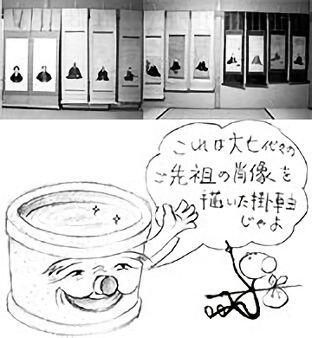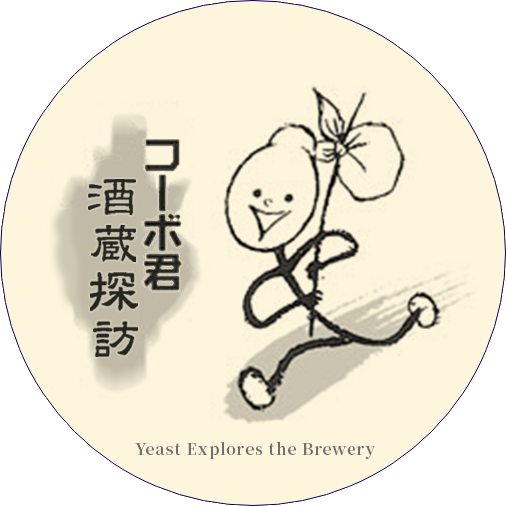| Yeast |
“Old Well, can you tell me today what kind of place Daishichi’s town, Nihonmatsu, is? |
| Old Well |
“To the west of Nihonmatsu lies Mt Adatara, and to the east are the Abukuma mountains. Right in the middle flows the river Abukuma from north to south. We are located a little to the north of the center of the Nakadori area of Fukushima prefecture. Nihonmatsu is very hilly, when you look down from the top of the hills the town lies like a miniature garden at your feet.” |
| Yeast |
“It must be cold in winter.” |
| Old Well |
“But it’s not a basin, so relative to the cold there is little snow. We have a typical inland climate with a large difference in temperature between day and night in summer.” |
| Yeast |
“The many thunderstorms are a bit frightening.” |
| Old Well |
“This type of climate is a condition for good rice cultivation. And it also fits well to sake brewing.” |
| Yeast |
“When did the Ohta family start brewing sake? I hear they came from the old Ise province?” |
| Old Well |
“According to tradition, when Lord Niwa moved to Nihonmatsu castle (1643), three Ohta brothers followed him all the way to Nihonmatsu from Tamaru in Ise. The brothers brought an Amida trinity with them, and divided the three Buddha statues over the three families for worship. The Ohta family was descended from the main line of the Seiwa Genji clan, and Ichizaemon, the eldest son, served as minister in the Tanakura domain. But after he came to Nihonmatsu, he switched from being a samurai to a merchant, and started brewing sake.” |
| Yeast |
“I see. Why was that?” |
|
 |
| Old Well |
“The new town at the foot of the castle was very lively. He must have opted to assist the castle lord by economic activities, as a purveyor to the castle.” |
| Yeast |
“Are those brothers the ancestors of Daishichi?” |
| Old Well |
“Not so fast. The second and third brother took up sake brewing under the brand name of Seshuya. Their father was our great ancestor Shigekata Ohta, who died in 1647. He was succeeded as family head by the second son, Chozaemon Ohta. And the third son was Saburobe.” |
| Yeast |
“Did they brew sake together?” |
| Old Well |
“No. Chozaemon’s family brewed sake under the brand name ‘Tanikaze’ and they also produced miso and soy sauce, becoming the top merchant family in the domain. And Saburobe prospered while brewing sake under the brand name ‘Kintoki.’” |
| Yeast |
“Which one is the ancestor of Daishichi?” |
| Old Well |
“That is Saburouemon Yoshichika, who became independent from the Saburobe line and set up the Daishichi Sake Brewery in Takeda. That was in 1752, when he was 32 years of age.” |
| Yeast |
“After that, from the third head the hereditary name Shichiuemon was adopted.” |
| Old Well |
“You’re well informed. Daishichi underwent a great development at the time of the 4th Shichiuemon in the late Edo period. At the time of a big fire he took speedy measures, and from the castle lord he received the gift of a quince tree.” |
| Yeast |
“That quince tree had been hit by lightning and was split in two. The 4th Generation believed that it was a protection against lightning as the same tree is never hit twice. The quince tree is still growing beautifully in Daishichi’s courtyard.” |
| Old Well |
“There are many other things to tell… especially the time of the 8th Shichiuemon was important. In 1917 when the 7th Generation suddenly died, he left Asaka Middle School at age 15 to become family head.” |
| Yeast |
“Was he only 15?” |
| Old Well |
“Yes. So he visited well-known breweries in Nada and in Akita to study sake brewing. In various ways this was a turning point. He laid the foundation for the modern Daishichi Sake Brewery.” |
| Yeast |
“Until this point the brand name had been Oyama, but that was changed into Daishichi by borrowing the “shichi” (seven) from the name “Shichiuemon.” |
| Old Well |
“Precisely. At the end of the Meiji period the convenient sokujomoto method was discovered, but the 8th Generation preserved the kimoto tradition because he wanted to follow his own ideals in sake brewing.” |
| Yeast |
“In 1938 he won the first prize at the 16th Japan Sake Awards, becoming the number one sake in the country.” |
| Old Well |
“Daishichi’s fame spread to the whole of Japan.” |
| Yeast |
“The preference for kimoto is today the great distinctive point of Daishichi. Old Well, let’s continue our efforts also from now on!” |





